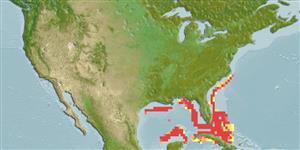Common names from other countries
>
Ophidiiformes (Cusk eels) >
Ophidiidae (Cusk-eels) > Ophidiinae
Etymology: Lepophidium: Latin, lepus, leporis = rabbit + Greek, ophis = serpent (Ref. 45335); crossotum: Name from Greek 'krossotos', meaning fringed, referring to the condition of the snout tip..
Environment: milieu / climate zone / depth range / distribution range
Sinh thái học
Biển Sống nổi và đáy; Mức độ sâu 91 - 384 m (Ref. 91765), usually 91 - 192 m (Ref. 91765). Tropical; 36°N - 21°N, 96°W - 75°W (Ref. 91765)
Western Atlantic: along the coast of the US from North Carolina (south of Cape Hatteras) to southern Florida and in the eastern Gulf of Mexico from western Florida to Yucatan.
Bộ gần gũi / Khối lượng (Trọng lượng) / Age
Maturity: Lm ? range ? - ? cm
Max length : 16.8 cm SL con đực/không giới tính; (Ref. 91765)
Short description
Khóa để định loại | Hình thái học | Sinh trắc học
Các vây lưng mềm (tổng cộng) : 117 - 125; Tia mềm vây hậu môn: 99 - 106; Động vật có xương sống: 68 - 69. This species is characterized by the following: fringed snout; differs from L. kallion and L. wileyi by fewer total vertebrae (67-69 vs. 71-75 and 70-75, respectively) and lateral line length in SL (87.8% vs. 88.8% and 91.5%, respectively); differs from L. kallion in the number of dorsal rays (117-125 vs. 129-137) and anal rays (99-106 vs. 108-114), average post orbital length in HL (48.6% vs. 56%), average orbit diameter in HL (30.9% vs. 25.4%), average body depth at occiput in SL (10.7% vs. 13.3%), at origin of dorsal fin (11.5% vs. 14.5%), at origin of anal fin (10.1% vs. 11.9%), average predorsal distance in SL (22.1% vs. 23.9%), average preanal distance in SL (35.6% vs. 39.6%); head and body color is pale brown and without pattern (Ref. 91765).
Life cycle and mating behavior
Maturities | Sự tái sinh sản | Spawnings | Egg(s) | Fecundities | Ấu trùng
Robins, C.R., R.H. Robins and M.E. Brown, 2012. A revision of Lepophidium (Teleoastei, Ophidiidae), with descriptions of eight new species. Bulletin of the Florida Museum of Natural History 52(1):1-94. (Ref. 91765)
IUCN Red List Status (Ref. 130435)
CITES (Ref. 128078)
Not Evaluated
Threat to humans
Harmless
Human uses
Các công cụ
Special reports
Download XML
Các nguồn internet
Estimates based on models
Preferred temperature (Ref.
115969): 17.5 - 24.4, mean 21.7 (based on 37 cells).
Phylogenetic diversity index (Ref.
82804): PD
50 = 0.5000 [Uniqueness, from 0.5 = low to 2.0 = high].
Bayesian length-weight: a=0.00102 (0.00046 - 0.00225), b=3.06 (2.88 - 3.24), in cm Total Length, based on all LWR estimates for this body shape (Ref.
93245).
Mức dinh dưỡng (Ref.
69278): 3.5 ±0.7 se; based on size and trophs of closest relatives
Thích nghi nhanh (Ref.
120179): Chiêù cao, thời gian nhân đôi của chủng quần tối thiểu là dưới 15 tháng (Preliminary K or Fecundity.).
Fishing Vulnerability (Ref.
59153): Low vulnerability (11 of 100).
